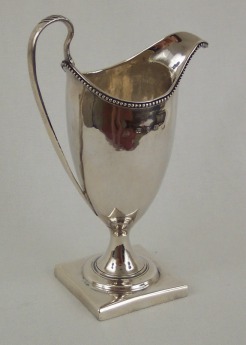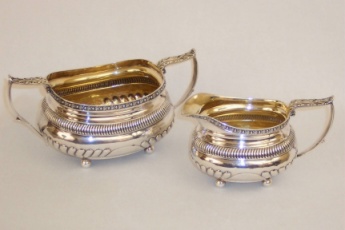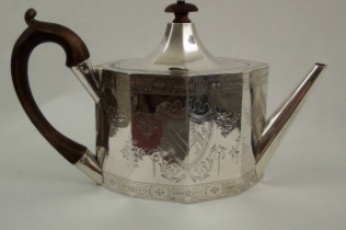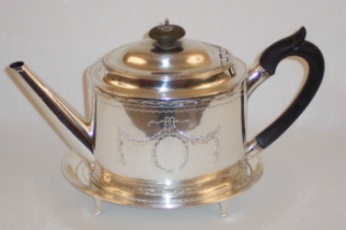click on images to enlarge
A female silversmith: Hester Bateman 1708 - 1794
Hester Batemans's long career began after the death of her husband
John Bateman(1704-1760). John was a chainmaker in London, but little is
known about him.
After his death, Hester began to build the business, entering her first
silver mark in 1761 and continuing to expand the business and went on to
be one of the best known of the female silversmiths working in London
during the 18th century.
 She
produced many items in her workshop such as, creamers, salvers,
teapots and serving pieces. While not as well respected as some of
the other fine female silver smiths like Ann Tanqueray and Elizabeth
Buteux, her work is certainly more affordable to the average
collector and there are more authentic pieces available on the
market. She
produced many items in her workshop such as, creamers, salvers,
teapots and serving pieces. While not as well respected as some of
the other fine female silver smiths like Ann Tanqueray and Elizabeth
Buteux, her work is certainly more affordable to the average
collector and there are more authentic pieces available on the
market. |
By bringing her children and their spouses into the business, she
created a family business which continued until long after her death.In
addition to Hester herself, she was later joined by her sons, Jonathan
(1747-1791) and Peter Bateman(1740-1825. After Jonathan's untimely death
in 1791, Peter joined with Jonathan's wife Ann and eventually William
Bateman I(1774-1850), who was the second son of Jonathan and Ann
Bateman, and Hester's grandson.
Together they produced silver pieces well into 1815, at which point
William registered his mark singularly. William was eventually followed
by his son William Bateman II who continued the family tradition and it
appears to have stopped at his death sometime between 1874 and 1877.
 As
collectables, Bateman antique silver pieces are sought after, with
pieces by Hester and Jonathan and Peter Bateman bringing the most.
Jonathan and Peter's mark was only used for 6 months, so it is
considered to be very rare. One additional point is that Hester's
pieces were often over struck, so use care and only purchase pieces
which are clearly marked, if you desire a true HB piece. As
collectables, Bateman antique silver pieces are sought after, with
pieces by Hester and Jonathan and Peter Bateman bringing the most.
Jonathan and Peter's mark was only used for 6 months, so it is
considered to be very rare. One additional point is that Hester's
pieces were often over struck, so use care and only purchase pieces
which are clearly marked, if you desire a true HB piece. |
Peter and Ann Bateman did many silver pieces, but were quite prolific
with sugar and creamers and they were eventually joined and then
succeeded by William Bateman. William is considered by many to be the
most talented of the family and produced many quality pieces during his
long career. The attention to detail and overall design of Williams's
antique silver pieces are notable and reflect an element of design that
is sometimes lacking in his relatives work.
To view Bateman pieces, I can recommend the Victoria and Albert Museum
in London and certainly one additional fine collection of Bateman and
many other fine makers is the Huntington Library in San Marino
California. All pieces illustrated in this article are available at The
Lion Passant.
|

|

|
Fine example of a shaped oval teapot done by Hester Bateman,
London 1789, just prior to her retirement. The beautiful bright cut
engraving and the fine design reflect the experience of a lifetime
of creating fine silver. The workmanship is excellent and literally
every surface is covered by the engraving.
|
Rare teapot and matching stand by the Bateman brothers, Jonathan
and Peter, London 1790. Sons of Hester Bateman, this mark was used
for only 6 months in 1790, due to Jonathanís untimely death.
|
copyright by Charles Cook ©
courtesy of The
Lion Passant - Georgian and antique English silver
|




